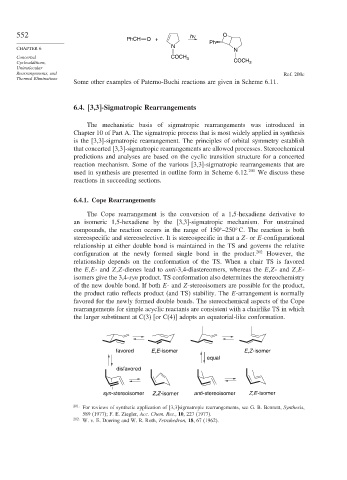Page 578 - Advanced Organic Chemistry Part B - Reactions & Synthesis
P. 578
552 h ν O
PhCH O +
Ph
N
CHAPTER 6 N
Concerted COCH 3
Cycloadditions, COCH 3
Unimolecular
Rearrangements, and Ref. 200c
Thermal Eliminations
Some other examples of Paterno-Buchi reactions are given in Scheme 6.11.
6.4. [3,3]-Sigmatropic Rearrangements
The mechanistic basis of sigmatropic rearrangements was introduced in
Chapter 10 of Part A. The sigmatropic process that is most widely applied in synthesis
is the [3,3]-sigmatropic rearrangement. The principles of orbital symmetry establish
that concerted [3,3]-sigmatropic rearrangements are allowed processes. Stereochemical
predictions and analyses are based on the cyclic transition structure for a concerted
reaction mechanism. Some of the various [3,3]-sigmatropic rearrangements that are
used in synthesis are presented in outline form in Scheme 6.12. 201 We discuss these
reactions in succeeding sections.
6.4.1. Cope Rearrangements
The Cope rearrangement is the conversion of a 1,5-hexadiene derivative to
an isomeric 1,5-hexadiene by the [3,3]-sigmatropic mechanism. For unstrained
compounds, the reaction occurs in the range of 150 –250 C. The reaction is both
stereospecific and stereoselective. It is stereospecific in that a Z-or E-configurational
relationship at either double bond is maintained in the TS and governs the relative
configuration at the newly formed single bond in the product. 202 However, the
relationship depends on the conformation of the TS. When a chair TS is favored
the E,E- and Z,Z-dienes lead to anti-3,4-diastereomers, whereas the E,Z- and Z,E-
isomers give the 3,4-syn product. TS conformation also determines the stereochemistry
of the new double bond. If both E- and Z-stereoisomers are possible for the product,
the product ratio reflects product (and TS) stability. The E-arrangement is normally
favored for the newly formed double bonds. The stereochemical aspects of the Cope
rearrangements for simple acyclic reactants are consistent with a chairlike TS in which
the larger substituent at C(3) [or C(4)] adopts an equatorial-like conformation.
favored E,E -isomer E,Z -isomer
equal
disfavored
syn -stereoisomer Z,Z -isomer anti -stereoisomer Z,E -isomer
201 For reviews of synthetic application of [3,3]sigmatropic rearrangements, see G. B. Bennett, Synthesis,
589 (1977); F. E. Ziegler, Acc. Chem. Res., 10, 227 (1977).
202
W. v. E. Doering and W. R. Roth, Tetrahedron, 18, 67 (1962).

